gardens
Field Guide to Phytoremediation
New York City contains over 30,000 vacant lots covering a combined 11,000 acres (nearly the size of Manhattan itself.) Much of this space can not be reused because of toxic contamination and the expense of excavating it. Enter the sunflowers.
Phytoremediation is the use of plants to remove contaminants from the environment. This Kickstarter campaign hopes to both publicize and demonstrate phytoremediation in NYC:
“In 2010, youarethecity created the Field Guide to Phytoremediation, a DIY handbook to cleaning up toxic soils in your own backyard, neighborhood vacant lot, or other urban space. Working with soil scientists, urban farming activists, community groups, and others interested on (and in) the ground, we have expanded this research. We need your help to make this process more visible and accessible to anyone. We want to print 2,000 copies of the field guide, to distribute for free, and to create on-site installations that illustrate and explain the process of phytoremediation at field lab sites throughout New York City.”
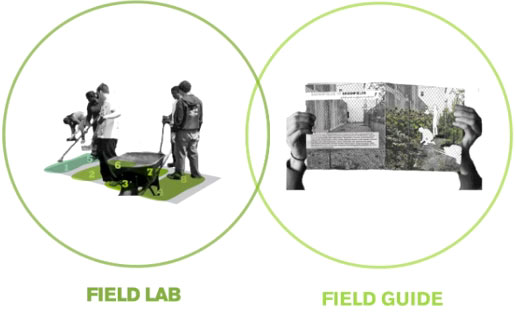
I’m in.
 Mud teaches gardening on a massive scale — across the LA County Unified School District. He raises funds, de-paves urban lots, works with kids, teaches teachers, and Twitters it all. This guy is busy! So it seems appropriate that this interview takes place via Twitter.
Mud teaches gardening on a massive scale — across the LA County Unified School District. He raises funds, de-paves urban lots, works with kids, teaches teachers, and Twitters it all. This guy is busy! So it seems appropriate that this interview takes place via Twitter.Neo Gardenism
At the intersection of urbanism, DIY, food justice and sustainable agriculture, a crop of artists are making open source gardens and sharing instructions on the web and beyond.
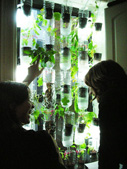 Britta Riley and Rebecca Bray build hydroponic Window Farms from recycled materials. The farms are specifically designed with New York City apartments in mind, and the website invites window gardeners to share photos, plans, designs and information.
Britta Riley and Rebecca Bray build hydroponic Window Farms from recycled materials. The farms are specifically designed with New York City apartments in mind, and the website invites window gardeners to share photos, plans, designs and information.
Edible Estates is a project to convert the classic American front lawn into a productive vegetable garden. Initiated by architect and artist Fritz Haeg on Independence Day, 2005, several prototype gardens were created in different cities across the United States, with instructions and documentation of the prototype gardens posted to the site. 2009 sites have not been announced, but the group is ideally looking for “A monotonous housing development of identical homes... where the interruption of the endless lawn would be dramatic and controversial.”
The Future Farmers’ Victory Gardens project is fought on two fronts: to deliver urban garden kits to urban farmers across San Francisco, and to ultimately develop and maintain a portion of the original Victory Garden space in San Francisco’s Golden Gate Park.
 The Garden is a feature-length documentary film about a 14-acre community garden in South Central Los Angeles that emerged in the wake of the 1992 LA riots. The film chronicles the origins of the plot and the South Central Farmers struggle to prevent it from being demolished.
The Garden is a feature-length documentary film about a 14-acre community garden in South Central Los Angeles that emerged in the wake of the 1992 LA riots. The film chronicles the origins of the plot and the South Central Farmers struggle to prevent it from being demolished.
On the more underground tip, Guerilla Gardening is illicit, nocturnal gardening in a space not your own. guerrillagardening.org lists projects, mostly in London, each with a description, location, photos, and budget. The site includes tips for making your own.

Seed bombing is packing seeds in compressed soil and throwing it into inhospitable or hard to reach places. Artist Liz Christy was the first to use the term in 1973 when she fought urban decay by tossing seed grenades full of sunflower seeds into abandoned New York City lots. Here’s a scan of her original instruction sheet. Christy also co-founded the first community garden in New York City.
 Moss graffiti is also good for damp, urban corners. Anna Garforth has done some beautiful work here. Here’s how to make your own.
Moss graffiti is also good for damp, urban corners. Anna Garforth has done some beautiful work here. Here’s how to make your own.
And onto Gardening 2.0: Landshare is a UK website matching people who want to grown their own food with homeowners with underused space. The site also hosts an active forum for sharing tips and answering questions.
And with your veggies in hand, VeggieTrader is a website for trade, buy or sell homegrown produce.
I’m sure there are many more sites and projects, too. Between the recession and growing concern about industrial food systems, there seems to be something of a renaissance going on here.
The Living Machine
It looks like a botanical garden, but it’s feasting on your sewage — reclaiming waste water for reuse. It’s bioremediation in action. It’s... a Living Machine, “a natural engine to clean water, grow food, regulate climate, even repair damaged habitats.”

“Living Machines accelerate nature’s own water purification process. Unlike chemically based systems, Living Machines incorporate helpful bacteria, plants, snails and fish that thrive by breaking down and digesting organic pollutants.
Wastewater treatment takes place through a series of differently managed environments, a diversity of organisms that eat the waste in the water.
Each Living Machine is custom designed by the engineers of Living Machines, Inc.
Living Machines, Inc. designs each Living Machine to meet each individual client’s needs and requirements. Living Machines typically treat wastewater with six different steps (reactors) or ecologies.”
Though the outputs are not drinkable, there are a variety of agricultural and industrial uses for the processed water.
More than thirty commercial-scale and pilot facilities located throughout the United States and seven other countries, range in size between 300 and 750,000 gallons per day.
The Living Machine system in South Burlington, Vermont cleans 80,000 gallons per day of municipal sewage, an amount typically generated by approximately 1,600 residential users. The waste stream is diverted from the City’s conventional treatment plant. Waste water from the Ethel M Chocolates plant runs through a Living Machine system:
“The treated wastewater is suitable for reuse for on-site landscape irrigation. Sludge is also treated on-site by a composting reed bed, making this a zero discharge facility.”
...
Ocean Arks International is a non-profit organization founded by Living Machine inventor John Todd. Ocean Arks applies the concepts behind the Living Machine to restoring damaged environments.
“Restorer 1” is a floating Living Machine gobbling the contamination of Flax Pond in Harwich, Massachusetts.
“After Flax Pond in Harwich, Massachusetts, a popular swimming and fishing spot and source of irrigation for Cape Cod’s cranberry bogs, was closed in the mid-1980’s due to pollution, Ocean Arks deployed a ‘replacement wetland’: a sun- and wind-powered raft that cycles 100,000 gallons of pond water through nine ecological cells. Three cells harbor microbes to break down the contaminants, and the other six cells, containing typical marsh plants and animals, filter water that then returns to the pond.
Since the Lake Restorer began operation in 1990, beaches have reappeared, oxygen in the water has increased, and the biodiversity of bottom-dwelling invertebrates has blossomed. Although pollutants from the adjacent landfill and septic waste basin continue to leach into the pond from contaminated groundwater, the pond is again safe for swimming and fishing.” [source]
“During the first two years of its operation, the Restorer Living Machine assisted in the digestion of 19,000 cubic meters of anoxic sediments, greatly improving benthic diversity. Additionally, we estimate that the Restorer removes more than 5 kg of ammonia from the pond through denitrification each year in its EFB’s.” [source]
Tyson Foods’s $6 million dollar settlement with the Department of Justice for polluting Maryland’s water included funding for new measures to control the agricultural run-off. In 2001, Ocean Arks International installed an array of 12 “Restorers” to treat the industrial wastewater stream from the Tyson Foods plant in Berlin, Maryland.
Redesigning the High Line
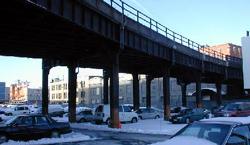

“Designing the High Line” is an exhibition of ideas for the conversion of the High Line elevated rail structure to public space. The exhibit is showing in Grand Central Terminal until July 26. 720 entries were submitted from 36 countries. More than 100 of the proposals, including the competition winners, are displayed in the Grand Central exhibit. All 720 entries are displayed on the Web site.
In addition to the four principal winners, designs were selected for special cash awards for depicting the most compelling solution for universal access to the elevated structure, and for incorporating plants and wild flowers native to New York. (Pictures are posted here and here, though difficult to read.)
The High Line runs for 1.45 miles over Manhattan’s West Side, from 34th Street down through Chelsea to Gansevoort Street in the Meat Packing District. The High Line was built during one of New York City’s largest infrastructure projects, the West Side Improvement project. The project took place in the early 1930’s during the Great Depression and was presided over by Robert Moses. The Line carried freight above the streets of the West Side until 1980, when the last boxcars hauled a load of frozen turkeys down the tracks. The structure has been inactive since, collecting trash, shedding rust, and sprouting an elevated garden of weeds and wildflowers. [more history here]
In 1992, the Chelsea Property Owners, a coalition of two dozen businesses who own property under and near the Line — mostly parking lots, machine shops, warehouses, and the trendy Chelsea Market — won a conditional demolition order from the Surface Transportation Board. The proposal to tear down the Line was later supported by Mayor Giuliani. The plan never materialized because the coalition and the railroad’s owner at the time, Conrail, could not agree on an ultimate price tag for demolition. [source]
Through the economic boom of the 90’s, however, new residents moved into the neighborhoods below the Line, among them artists, designers, and galleries. In 1999, an altogether different group of neighborhood residents founded Friends of the High Line, a 501(c)(3) non-profit organization with the mission of converting the structure to an elevated public space.
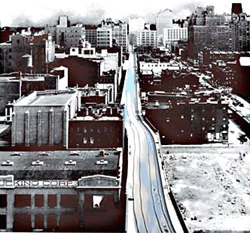 And, after much lobbying, it looks like the High Line might actually be redesigned. At the July 9 benefit preview of the exhibition, New York City Council Speaker Gifford Miller announced a $15.75 million funding commitment for planning and construction. The first $750,000 was allocated in the budget adopted by the New York City Council on June 27.
And, after much lobbying, it looks like the High Line might actually be redesigned. At the July 9 benefit preview of the exhibition, New York City Council Speaker Gifford Miller announced a $15.75 million funding commitment for planning and construction. The first $750,000 was allocated in the budget adopted by the New York City Council on June 27.
“The funds can be used for planning, design, and construction costs related to the High Line project during the fiscal year that began July 1. The remainder of the $15.75 million commitment will be allocated to the High Line in the following three fiscal years.
‘The High Line was built during the Depression to invigorate New York’s economy, and it will reinvigorate our City again today,’ said Speaker Miller. ‘As we have learned from our City’s great parks, public spaces create value and catalyze growth. Central Park was planned in a recession. Even in tough economic times, we have to invest in our future—by planning for the public projects that will keep us at the forefront of the world’s great cities.’
The funds will come from the City’s capital budget, which pays for project costs such as planning, design, construction, and long-term leases. The allocation will not affect municipal services, which are funded separately through the City’s expense budget.” [source]
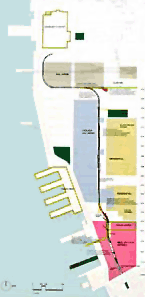 The Friends of the High Line are also seeking private, corporate, foundation, and federal funds for the project.
The Friends of the High Line are also seeking private, corporate, foundation, and federal funds for the project.
The competition follows two detailed planning studies: Reclaiming the High Line, sponsored by Friends of the High Line and the Design Trust for Public Space; and a comprehensive economic feasibility study, commissioned at the City’s request.
In December 2002, the City of New York took the first step in converting the High Line to a public walkway through federal rails-to-trails legislation. FHL is currently waiting on decision before Federal surface transportation board to allow City to move forward.
“As the next phase in its project to preserve and re-use the High Line, Friends of the High Line will hold a series of open workshops with members of the community beginning in September, with a variety of the competition proposals serving as springboards for discussion. At the end of 2003, Friends of the High Line will incorporate the community’s comments into a Request for Proposals, which will lead to the development of realizable designs.” [source]
The High Line is currently private property, owned by the rail company CSX Corporation. CSX acquired the High Line when it purchased Conrail in 1997. Conrail was created by the federal government in 1970’s from the remains of the New York Central and other railroads bankrupted by “competition from trucks, subsidized by the federally-built Interstate highway system, and an archiac system of economic regulations which prevented railroads from responding to the needs of the market.” The corporation was sold to the public in 1987, in what was then the nation’s biggest IPO. [more on Conrail] Though the High Line is private property, the federal government, specifically the Surface Transportation Board, has control over the Line as a piece of the nation’s rail infrastructure. CSX has been ordered by the government to work with all interested parties to effect the best exit strategy for the High Line, and to remain neutral as to the High Line’s outcome.
The City can not afford to purchase land under High Line, so has instead proposed rezoning and property transfer, moving air and development rights out to sites around West Chelsea. One potential consequence would be a wall of huge residential towers springing up along 10th and 11th Avenues in otherwise moderately sized manufacturing and retail zones. One challenge faced by city planners is the prevention such “massing.”
The High Line snakes through many neighborhoods and buildings, but sits almost entirely within the area served by Manhattan Community Board No. 4. The current Line blocks sunlight, collects trash, and drops water, rust, and pigeon droppings on the streets below. However, according to a survey by the Board, most community residents support conversion over demolition. They want to make sure, though, that the results of the redesign are the best damn park possible. The community is wary of new large-scale structures or billboards that would block sight of or access to the Hudson River. The project should provide open space for cultural programing, be accessible, and safe, providing a way to get up or down quickly. But most of all, it should connect with and respect the community. Some residential buildings sit within 5 feet of Line.
As development proceeds, areas beneath and adjacent to High Line will become lucrative spots for retail. Indeed, represenatives of our businessman-turned-Mayor is keen to move some of that retail up onto High Line itself. Other possibilities include constructing adjacent buildings with roof access that would meet the High Line or produce huge urban stairs, parks that terrace up to the bed of High Line, which is about 30 feet from the ground.
At a panel discussion, I asked Robert Hammond, co-founder of Friends of the High Line, about their advocacy strategy and how design competition fits into it. The competition took a year to organize from beginning to end and was a way to get people excited, to generate activism and support, and to provide a public platform for discussion. He noted the power of crazy, weird ideas - and how it is often easier to draw attention and support for the crazy ideas than the conservative plans. Another panelist noted that, when not located to a specific neighborhood, the constituency of public open space is transient and often does not have a consistent voice. The competition was an opportunity “to get those ideas out there.” Over the years, many have developed redesigns of the High Line for their thesis projects.
I asked Mr. Hammond what has led to their success to date while civic budgets are being cut and other projects around the city have faltered. Mr. Hammond proposed that the support base was “not the usual mix of neighborhood advocates.... The strongest supporters are architects, artists, art dealers.” Indeed a list of supporters at the gala benefit includes many A-list authors, actors, and artists. Not your usual city planning scene.
Mr. Hammond also noted that the design of their campaign materials was also key. Several designers have donated services to develop graphically sophisticated materials. Brochures, Web site, postcards for public comment... “Everything produced looks interesting. It suggests that the final design will be as innovative.”
Ironically, development of the High Line may push many in the arts community to leave the area. When the project is complete, rents around the Line are likely to increase. Many arts spaces are already midway through their 10 year lease, and unable to afford the current market rents. Part of the development plans could create public spaces that would not command retail rents and could support galleries, though these would be limited.
So how will the crazy ideas not get lost, or bogged down by politics? And allow ultimate designer to maintain poetic vision? The challenge is yet to come. Once New York realizes that the project is possible, everyone will want a piece of the action. It will be important to maintain a clear vision, and to make sure the final product is as extraordinary, interesting, and strange as the High Line itself.
Check out these photo galleries on the current state of the High Line.
The High Line was mentioned here in one of my first blog posts.
Green Roofs
“Choosing an environmentally responsible roofing material can be one of the greatest challenges of green building. Roofing materials tend to be expensive, damage- and failure-prone, and often contribute to demolition waste. An option which has long been popular in Europe, and is gaining increasing favor in the United States, is the vegetative-cover, or green, roof. Designing a roof with plant cover has several environmental benefits. It can reduce rooftop temperature, in turn reducing building cooling costs and even preventing urban heat islands. Additionally, green roofs are an important tool in stormwater management, because they prevent runoff. Finally, plant-covered roofs can play a role in providing urban habitat for songbirds and butterflies, and in improving air quality.”
From the U.S. Department of Energy.
So what exactly is a green roof?
Linda Velazquez writes by email that “a traditional roof garden is a roof deck (concrete, wood, etc.) with potted plants in various types of free standing containers,” while green roof is an extension of the existing roof which involves a special root repelling membrane, a drainage system, a lightweight growing medium, and plants.
“All the green roof component layers cover the entire roof deck surface. Specifically, the roof deck, insulation, waterproofing membrane(s), root resistant layer, drainage, non-woven filter fabric, engineered soil mix, plants (and sometimes a biodegradable erosion control blanket). So, the entire deck has unimpeded drainage over the entire roof, and the weight of soil and plants is more evenly distributed over the entire roof. And the plants are planted directly into the soil, which in effect, looks like the roof deck.
And there will be a few additional layers (protection, vapor barrier board, etc.) that are applied over an intensive green roof system, as the soil depths are deeper, weights are greater, etc. You can also add architectural accents, like paths, arbors, fountains, etc., but these are built onto the roof deck before the layers are put on the roof deck.”
In an article on green roofs, Katrin Scholz-Barth writes:
There are two distinctly different types of green roofs: intensive and extensive. Intensive green roofs require a minimum of one foot of soil depth to create a more traditional roof garden, with large trees, shrubs and other manicured landscapes. They are multi-layer constructions with elaborate irrigation and drainage systems. Intensive green roofs add considerable load (from 80 to 150 pounds per square foot) to a structure and require intensive maintenance. These roof gardens are, however, designed to be accessible and are used as parks or building amenities.
In contrast, extensive green roofs range from as little as 1 to 5 inches in soil depth. Depending on the soil depth and type of substrate, loads can vary from 15 lbs/sf to 50 lbs/sf. For instance, historic green roofs in Berlin, Germany, built around 1900, weigh about 42 lbs/sf. Extensive green roofs are not designed for public use but can be accessed for routine maintenance walks, generally performed once per year. Extensive green roofs are primarily built for their environmental benefits.
Although everything from earth-bermed [partially underground] houses to balconies with potted plants has conveniently been termed a ‘green roof’ at one point or another, this article strictly defines extensive green roofs as elevated roof surfaces that are entirely covered with a thin soil and vegetation layer. They are not necessarily sod or grass roofs... Additionally, the term eco-roofs is not used in this context because products such as wood shingles are also made of natural, renewable materials, and would thus qualify as an eco-roof.
Green roofs can create recreational space while simultaneously address urban environmental issues like smog, climate change, stormwater management, and energy conservation, though there is the additional upfront expense for builders. Europe is far ahead of the U.S. Green Roofs for Healthy Cities:
“In North America, the benefits of green roof technologies are poorly understood and the market remains immature, despite the efforts of several industry leaders. In Europe however, these technologies have become very well established. This has been the direct result of government legislative and financial support, at both the state and municipal level. Such support recognizes the many tangible and intangible public benefits of green roofs. This support has led to the creation of a vibrant, multi-million dollar market for green roof products and services in Germany, France, Austria and Switzerland among others.”
From City Farmer, Canada’s Office of Urban Agriculture:
“In some parts of Germany, new industrial buildings must have green roofs by law; in Swiss cities, regulations now require new construction to relocate the area of greenspace covered up by the building’s footprint to the rooftop - and even existing buildings, some hundreds of years old, must convert 20% of their roofspace to pasture.”
Green roofs also cool down urban areas in summer, saving energy. The combination of dark surfaces and less vegetation in cities creates what’s called the heat island effect:
“On warm summer days, the air in urban areas can be 6-8°F hotter than its surrounding areas. Scientists call these cities ‘urban heat islands.’ The higher temperatures in urban heat islands increases air conditioning and raises pollution levels.”
The Gauntlet and The Happy Place
San Francisco’s Boeddeker Park was “designed with safety and security in mind, but in all the wrong ways.” The 2.6-acre park is cut off from the streets by fences and walls, thouch “meant to provide safety instead make the place feel like a cage.” “The main, bench-lined walkway through the park became known as ‘the Gauntlet’ after it was colonized by drug dealers a year or so after the park’s 1985 opening.” In contrast, Harlem’s El Sitio Feliz incorporates “water play, swings, slides and a small picnic pavilion with community gardens, [the site] has become well-known for its creative combination of activities for children and adults. The most popular play equipment is a simple garden hose, which kids use to spray each other and keep the slide slippery. The playground is flanked by community gardens, tended regularly by local residents who seem to enjoy the frequent interaction with children.” Check out Great Public Spaces and the Hall of Shame at Public Buildings & Civic Design, a site with lots of bite-sized case studies brought to you by the Project for Public Spaces, “helping people to grow their public space into vital community places.”

